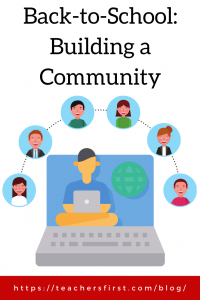
Teachers, parents, and students are focusing on back-to-school preparations as summer draws to a close. The feverish attempt to prepare for the school year is challenging, even without a pandemic. As we focus on what we’re teaching and how we’re going to teach it, it can be easy to forget how important it is to connect and establish relationships with our students and families. In reality, our students don’t care how much we know until they know how much we care. This platitude still rings true in our “new normal.” No matter where our students are learning and where we are teaching, the first few weeks of school are pivotal for building relationships and community with our students and their families.
Teachers are returning to face-to-face instruction, online instruction, or hybrid models of learning. We are planners, but we’re also agile to respond and react to the needs of our students. The pandemic magnifies the uncertainty of a new school year, but I have yet to meet a teacher not ready to tackle the challenge. As we approach the first day of school, it’s vital to remember the words of Dr. Brad Johnson “relationships before rigor, grace before grades, patience before progress, love before lessons.” The following communication strategies and resources will help you establish a classroom community and connect with your families and students.
Screencasting
A screencast is a digital recording of your actions on a computer or tablet with audio narration. There are several ways you can use screencasting to communicate and connect with your classroom community.
While we often have our students create “All About Me” assignments to begin the year, it’s also important for us to share about ourselves. You can use a screencasting tool like Screencastify (reviewed here) or Screencast-o-matic (reviewed here) to narrate a short introduction with pictures and information about you. Students will enjoy learning about you and will have a chance to make connections with you through the information shared in your screencast.
You can also create short screencast tours of your learning management system so students and families can learn how to access resources and materials. Providing directions in a screencast also allows students to rewind and review the assignment expectations as needed. This strategy also offers more time for the teacher to move around the room and assist the students or address questions online.
Screencasting is also an efficient and effective way to provide feedback on student assignments and assessments. Instead of just returning a grade, share a screencast video of you speaking to the student about their work. The student could also respond through a video or type their response. You can release the grade on the assignment after the student engages with your feedback, emphasizing the learning process instead of the final grade.
You want to keep your screencasts short and focused while sounding conversational in your delivery. The viewer will have a better connection if the screencast seems natural, so don’t worry if it’s not perfect. If possible, use closed captioning of your narration to enhance the accessibility and viewing experience.
Communication
Communication is the cornerstone of a classroom. It’s imperative to establish how you’re going to communicate with your students and families, to make sure the mediums you use to communicate are approved by your school district’s acceptable use policy, and to provide multiple means of communication to reach all members of your classroom community.
Some families may prefer text message updates from Remind (Reviewed Here) or to receive all classroom correspondence through email. Make sure all families receive the same information through the various mediums you offer. If you are only sending reminders through text message updates, families that are not subscribed are not receiving the same information. It is also important to make sure families understand the best ways to reach you and when you can respond.
Writing letters or postcards is also a fun way to connect with your students and their families and allows you to reach families who don’t have access to technology. You can also ask supermarkets or other high-traffic areas to post flyers or posters with important back-to-school information on their bulletin boards. Creativity is essential to make sure we reach all of our families.
Back-to-school preparation presents new challenges this year. Our school year’s success hinges on the strength of our communication and the social and emotional relationships we establish. How are you communicating with your students and families this year? We’d love to hear your strategies in the comments below!

